Did you see our favorites?
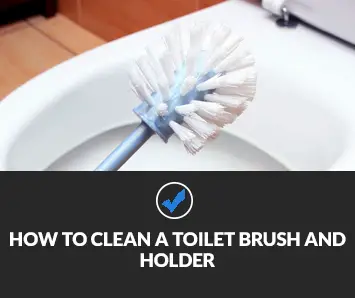
Cleaning toilet brushes and holders is rarely something that people consider or are aware they need to do. Most people forget or neglect to sanitize their equipment after cleaning them with these chemicals and storing them in their holders. It’s crucial to understand that these things aren’t self-cleaning, and even antibacterial products must be washed and disinfected.
Toilets are inhabited by a plethora of germs, viruses, and other illness-causing organisms. Toiletry brushes and holders are infested with bacteria and viruses that infect people when used. Germs instead of being curbed are spread due to the fact that these items aren’t cleaned or maintained properly. As a result, toilet brushes and brush holders should be washed and disinfected on a regular basis.
If you must, avoid thinking about it for too long and instead make a plan to wash your toilet-cleaning supplies this weekend.

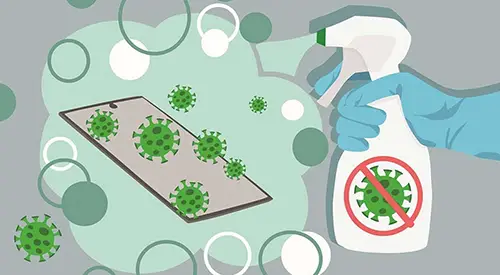
Sanitizing your cleaning supplies is crucial for preventing the transmission of disease-causing organisms such as E. coli, Staph, Salmonella, Campylobacter, Shigella, and other germs.
It is also critical to properly wash and disinfect toilet brushes and their storage containers to enhance the shelf life of these goods. Brushes and holders of high quality can be costly, but if you utilize them correctly and clean them thoroughly, they will last longer. Professional end-of-tenancy cleaners in Melbourne ensure that their supplies are properly sanitized and disinfected before being used, so do yourself a favor.
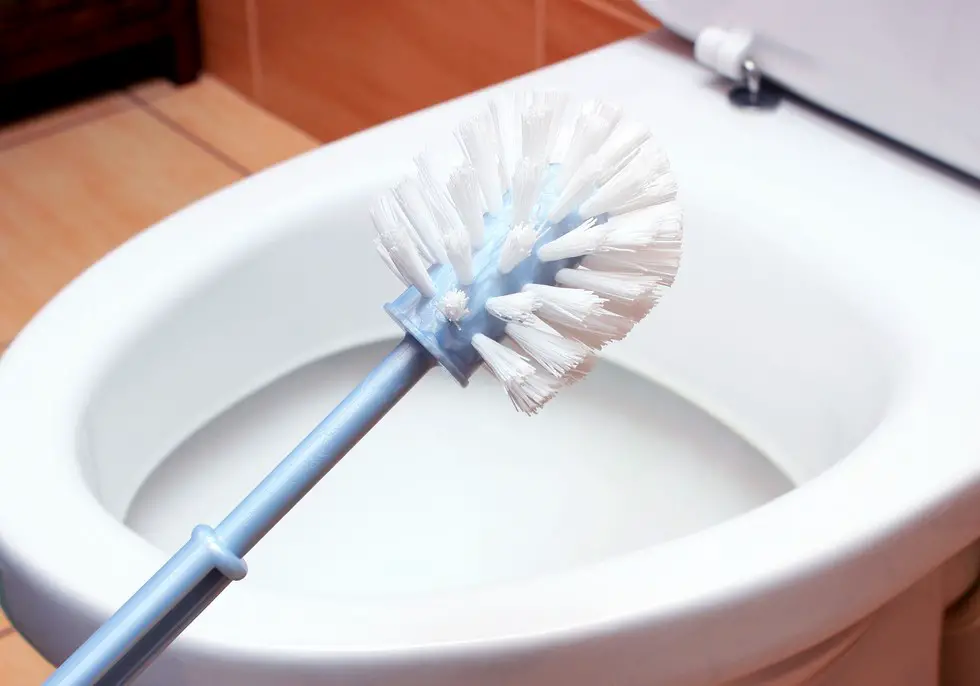
Toiletry brushes and brush holders are necessary cleaning equipment that should be in every house. These instruments are frequently employed, therefore it is critical to think about the following issues before purchasing them.
You don’t want to spend money on new brushes and holders that break frequently. It’s a waste of money and time to keep replacing these items of frequent usage. As a result, invest in high-quality brushes and holders that will last a long time.
Get brushes and holders that are the ideal size for cleaning your toilet. Buying brushes too big or small for your toilet will make them unsuitable cleaning tools.
Invest in toilet brushes and holders with useful designs. The brush’s head should be able to clean the bowl while its bends are flexible. Brush holders should keep brushes upright and protected.
Before you buy them, consider the characteristics of these items. Your brush should be soft but sturdy, and the bristles should have a good count. Its handle should also be long and comfortable to grasp. Toilet brush holders should be heavy-duty and come with non-slip bases to prevent the holder from tipping or sliding when the brush is put in it.

Many people overlook the necessity of maintaining their cleaning equipment. The toilet brush and its rack are one of the dirtiest objects in your bathroom. Because of continuous and frequent usage, the toilet becomes so filthy that it is impossible to use it without becoming disgusted. Your brush may be dirty because you store it when it is not completely dry. Using your toilet brush correctly and cleaning it on a regular basis can help make your bathroom more sanitary and refreshed.
First, you’ll need:

Fill a pail halfway with hot water and bleach. Make sure the bucket is big enough to fit your toilet brush and holder after they’ve been completely submerged. Fill the pail with the hottest water you can get your hands on. After that, add 2 cups (470 mL) of bleach to the mix.
Check the labeling on your bleach bottle. If it tells you to do something in particular, do it. If you don’t have a bucket, pour the bleach into the toilet bowl instead. After that, put the toilet brush inside the toilet bowl and leave it for a few hours or overnight.
Allow the brush and container to soak in bleach for one hour. Place them in the bucket gently and avoid splashing them. To prevent bleach from staining your skin/clothes or injuring your eyes, wear gloves and, if available, a disposable plastic apron. Allow the brush and holder to soak for at least 1 hour.
Clean the brush and container under hot water after usage. Fill the tub halfway with water as hot as you can. Place both under the water for at least 30 seconds to dissolve the active ingredient in bleach.
Before putting them away, dry the brush and holder. After washing, set the brush and container on a towel to dry. Don’t put them away until they’re completely dry. Bacteria will develop if your brush is damp or wet when it’s kept.
Repeat the bleaching process at least once a month. The toilet brush, no matter how seldom you use it, will continue to attract germs and accumulate dirt. It is suggested that you clean it monthly. If you don’t utilize the toilet brush very often, you may bathe it less frequently.
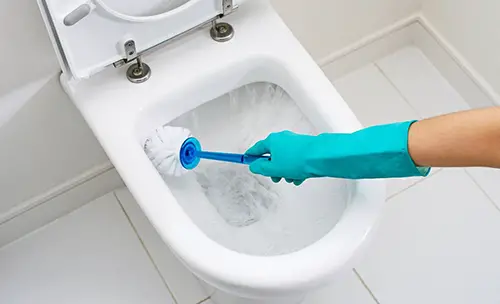
Make sure the toilet brush is completely coated with disinfectant. Any disinfecting solution will do; however, a mild one is ideal. Cover the entire surface area of the brush when spraying it. Spray until the bristles are damp; don’t stop till then. To clean out the toilet bowl, spray the brush over it.
For 10 minutes, lay the brush handle beneath the toilet seat. The toilet seat’s weight will keep the brush handle in place. The bristles of the brush should extend over the toilet bowl. Allow all of the excess disinfectant to flow into the toilet. It is a good idea to leave the brush for at least 10 minutes to drip dry on its own. You may also use a sink or a tub to dry it. If you do this, be sure to clean the sink and tub thoroughly afterward.
Brush the dog’s fur under hot water. If the sink is small, try to use the hottest water you can get your hands on. The brush bristles should be submerged beneath the water andwashed. Keep the brush in place until the run-off from it is completely clear.
Repeat the disinfection procedure with the brush holder. Spray the container with disinfectant and leave it to rest for 10 minutes. You may either set the holder on a towel or a paper towel to dry. After 10 minutes, fill the holder with hot water.
Brush and holder should be kept separate. When both the brush and its container are completely dry, lay them out on a towel to air-dry. After they’ve both thoroughly dried, put the brush in the holder and store it. Make sure both are totally dry before storing them; if you store them damp or wet, germs will grow.
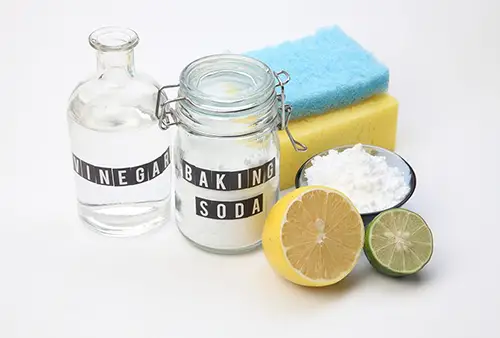
Scrub the brush with 2 grams (0.071 oz) of baking soda. Wear rubber gloves and a plastic apron. Sprinkle 2 grams (0.071 oz) of baking soda over the brush’s surface area. Use a different brush to aggressively scrub between the bristles to clean. While this step isn’t required, it does help to make things cleaner.
Run the brush and holder under hot water. Use the hottest water you have. For at least 30 seconds, leave the brush and holder under the water. Remove neither from the water until the runoff is clear.
Leave the brush and holder out to dry and then store them. Let them dry in a cool place. When both are fully dry, store them. Bacteria growth will occur if they’re kept wet or damp.

If the toilet brush is full of germs, dirt, and hard water particles, it will have brown stains on it. To clean and disinfect the brush, you must do two procedures: one to remove the brown stains from the brush and another to clean and disinfect it.
Fill a pail halfway with a cup of baking soda, a cup of vinegar, and boiling water and soak the toilet brush in it for the brown stains. Allow for some time before rinsing with boiling water instead of bleach or hydrogen peroxide as previously suggested.
Repeat the procedure if further stains persist. Allow it to dry before putting it away if the stains are still there after washing.
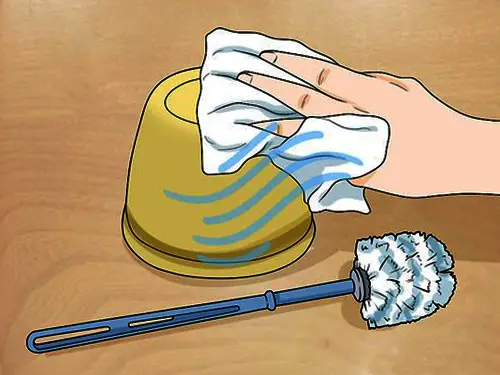
Now that you’ve cleaned your toilet brush, it’s also vital to clean the holder. It makes no sense to stick a recently disinfected brush into a filthy, germ-infested brush holder. Cleaning a toilet brush holder is quick and simple and can be done while your toilet brush is drying. To spritz the inside and outside of the toilet brush holder with a disinfection spray like Domestos Bleach Spray. If you don’t have access to bleach spray, prepare a solution of bleach for an hour as outlined above. Always follow the safety precautions on the product you’re using.
Simply hold the brush holder over the toilet bowl for approximately 10 minutes after it’s been bleached. Finally, wash the holder with boiling water and dry off both the bowl and the holder using a towel or tissue. That’s all there is to it; simply replace your toilet brush in its place once you’ve completed these procedures.

The plunger isn’t exactly a cleaning tool, but it does require regular cleaning since the messes it gets itself into necessitate it. You should clean your plunger thoroughly every time you use it to prevent clogs. To begin, fill the toilet with water and run the water while flushing the plunger. Finally, do a bleach bath. If your toilet bowl is deep enough, add some bleach or another disinfecting detergent to the toilet bowl full of clean water, then swish and soak the plunger for as long as required to de-grossify it. After that, wash the bowl and plunger with fresh water, then allow them to air dry somewhere handy.
You don’t have to clean your toilet brush cleaner after every cleaning of the toilet, but you should do it on a regular basis. Depending on how many people live in your house and how much usage your toilet gets, you may want to clean your toilet brush once a week. A foul odor or color change on the bristles is one sure indication that it’s time to clean your toilet brush.

What should you put in a toilet brush holder? Apart from the brush, nothing unless you want to add a pleasant aroma to your bathroom. You may also add a few droplets of fragrant oil in this instance. It is preferable not to fill the container with anything and simply clean the brush handle, bristles, and case at least once a week.
A plastic bucket with either a disinfectant or a bleach solution for keeping germs and bacteria off of your cleaning equipment will extend the life of your tools. Furthermore, it’ll guarantee that you have a clean toilet brush on hand whenever you need it. Finally, if they’ve been used for several years, you may always replace them.
Did you see our favorites?
CleaningProductsLab.com is a participant in the Amazon.com Services LLC Associates Program. As an Amazon Associate we earn from qualifying purchases.
Amazon and the Amazon logo are trademarks of Amazon.com, Inc. or its affiliates.
The information on this blog is not meant as a substitute for medical advice, and should not be taken as such.